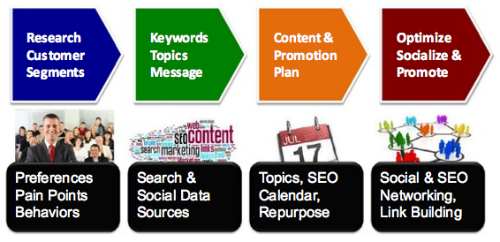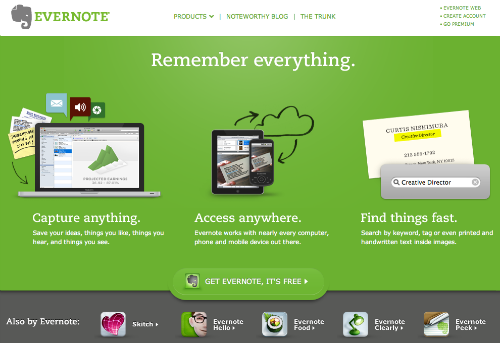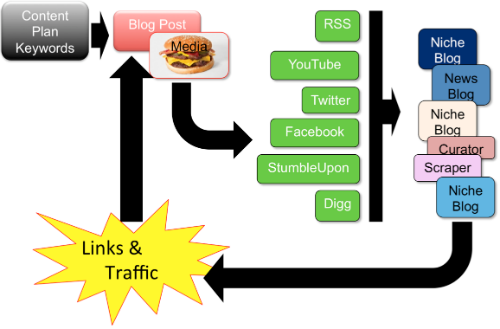
Thousands if not tens of thousands of new companies are formed every month in the U.S. and one of the most common problems to be solved relates to creating awareness, interest and motivation to buy. Is buying Google AdWords, throwing up a blog and a Facebook Fan page the answer? What about sending out Tweets, press releases and investing in SEO? If your start-up is executing content marketing tactics without first hand insight into the market and target customers, those tactics are a crapshoot. The irony is that most start-ups don’t have a lot of money to waste on marketing and advertising. But they do, every day. And so do many of the people reading this blog post.
Never fear, that’s why Optimize is here.
Start with What’s Important: While there’s plenty of great marketing advice out there, it will never solve the problems of an imperfect product. Creating great products and customer experience is probably one of the most important marketing investments a company can make. Outside of that, identifying compelling stories about how the product or service solves problems, meets a need or adds value for customers are essential steps for start-ups and established companies alike.
A great example of a company that inspires marketing by it’s fans and customers because the product quality and experience is so good, is Evernote.

There are over 76 million references to Evernote on Google.com and over 8 1/2 million references on blogs. On Twitter there are positive references every hour like “oh wow! I love Evernote and use it everyday” and “Evernote ftw. it’s not just about the list, it’s about the sync as well – smile”. That steady stream of unsolicited endorsement (and social content) is a tremendous marketing asset.
You Can’t Score Sales Without A Goal. The framework for implementing a holistic and strategic approach to Content Marketing starts by answering key questions including establishing goals ranging from overall revenue to cost efficiency of marketing and advertising tactics. Then identify what methods of measurement you’ll use as well as Key Performance Indicators to track progress towards your goals. Forecast or hypothesize what measurable impact on the business there will be and how to track progress over time.
BTW, some great people and resources on measurement for search and social media marketing as well as online media and communications on Twitter include: Katie Payne, Chuck Hemann, Shonali Burke, Jim Sterne, Marshall Sponder, Eric Peterson, Avinash Kaushik. There are more I know, so please share your faves in the comments.
With that foundation of establishing goals and identifying an approach to measurement, follow through these steps:
Get to Know Your Customers:
It’s one thing to optimize content using specific keywords researched for SEO purposes. But rather than start with keywords, what about starting with customers? In the advertising, content and direct marketing worlds (even web development and user experience) there’s specific attention paid to understanding customer segments and creating profiles or personas to guide the most successful approach. By empathizing with customer categories of interest, pain points and behaviors, a qualitative picture emerges of what kind of content, topics and optimization can be focused on in order to achieve business goals.
That insight into what customers care about can be translated into search keywords and social topics used for specific content optimization on a start-up’s website. It can also be used to inspire social content creation for sharing on sites like Facebook, Twitter or Reddit where customers spend time and are influenced. Which keywords to use and which social channels to spend time on depends on your research. And that research is ongoing – something that is iteratively and continuously refined.
David Meerman Scott has explored buyer personas quite well in his book, New Rules of Marketing and PR. Vanessa Fox has some great advice on searcher personas in her book, Marketing in the Age of Google.
Where Does The Money Come From: Keywords or Customers? Most SEO practitioners focus solely on keywords, popularity and relevance to the brand’s website content and rely on the brand to figure out relevance to customer needs. The problem is, many companies simply don’t do that homework. They decide internally what content to publish online without consideration of specific customer-centric perceptions of the problem that the brand’s product and services are to solve. That causes a disconnect and performance issues when the SEO practitioner achieves top keyword visibility but corresponding increases in sales don’t follow.
Few things are more frustrating for a SEO consultant (and the client) than to deliver top keyword visibility and traffic as promised, but only to be deemed a failed program because there was no corresponding increase in sales. That’s a conversion optimization issue in many cases, but also a disconnect in how keyword research was conducted relevant to actual customer needs.
Identify Search Keywords & Social Topics:
Understanding the drivers for why customers seek information online will help marketers identify what topics are the best reflection of meeting those needs. From a SEO and content marketing perspective, that means keywords. Keywords are a reflection of what customers care about and should serve as a guide for on-page optimization and link building efforts. At the same time, customers are not just influenced by search in their journey from discovery to purchase. Social media influences are increasingly a part of the buying cycle.
Another way to manifest what customers care about into actionable marketing is to understand what social topics are relevant for your business. Find out what people are “talking about” on the social web through comments, blog posts, tags, updates and tweets as it relates to your business and the customers you’re after.
As search keywords are managed with a keyword glossary, social topics can be managed or tracked as well. See this post on fixed list keywords and dynamic social topics for more. The combination of search keywords and social topics can keep start-up marketers on track and efficient with their editorial plans and proactive efforts towards ongoing optimization and social content creation. The tie-in to social media monitoring and web analytics will help refine messaging to be more effective at generating leads, sales or whatever your objectives might be.
Ron Jones just came out with a book dedicated to the task of keyword research called Keyword Intelligence that is worth checking out. Also, Bill Hunt has an awesome presentation on Advanced Keyword Modeling that he’s given at SES events.
Create a Content and Promotion Plan:
Once you have a solid keyword glossary, a next step is to create an editorial plan to identify and manage what content you’ll create when and for what topics, customer segments and intended outcomes. Sprinkling keywords in the right places on existing content is technically SEO, but it’s simply not enough to be competitive. Becoming the most relevant answer for a search query means ongoing creation and optimization of content that supports the topic. This extends to social content and networking/sharing channels as well.
Think of it in terms of signals of credibility. Wherever your customers can be influenced along their journey from awareness to decision to advocacy is where you’ll want to create optimized and socialized content. A content promotion plan includes dates, topics, keywords, categories, tags, media types, promotion channels and where the content will be re-purposed in the future. Here are two work horses for such a task: keyword glossary and editorial plan (blog).

Implement Optimization, Socialization & Promotion:
This is where the rubber hits the road and content is created, optimized and socialized. If you think of each piece of content as having a purpose for a particular audience segment, then it follows that you’ll want that content to be relevant at communicating your brand’s unique selling proposition (USP) as well as relevant for keywords customers are searching on. Unfortunately, creating really fantastic and relevant content isn’t enough. Promotion of that content is important in order to gain the visibility that results in broad based sharing. You know: tell 2 friends who tell 2 friends, and so on.
When it comes to great resources for SEO Copywriting and Content Marketing, I have to mention: Heather Lloyd Martin’s SEO Copywriting class, Joe Pulizzi’s Content Marketing Institute, Content Rules by Ann Handley & CC Chapman, Content Marketing by Rebecca Lieb and Accelerate by Arnie Kuenn. Last, but not least, is my own book about Content Marketing, SEO and Social Media Marketing that’s coming out in March of next year called, Optimize (Wiley).
Not all content is created equal when it comes to promotion, so be realistic about expectations and the resources you’ll need. Also, don’t treat your promotable content like a one-night stand. For most start-ups, the goal isn’t just to get a sale here and there, but to build a successful business. That means a persistent effort to stay top of mind and relevant amongst a growing community of customers and fans. Feed that community with themes of social content and participation and they will reward your start-up by interacting and sharing to networks beyond your reach. Interacting with a growing community will also supply an infinite number of relevant topics for future content.
Limited resources and a rush to revenue can cause many start-ups to make rash decisions about their online marketing mix. When it comes to content and better connections with customers, making an effort to develop customer-centric content with an optimize and socialize approach to promotion will help grow momentum, sales and referrals for short and long term success.
If you work with a start-up on marketing, what are some of the most common challenges you’ve faced with regard to content? What about social media and SEO?


